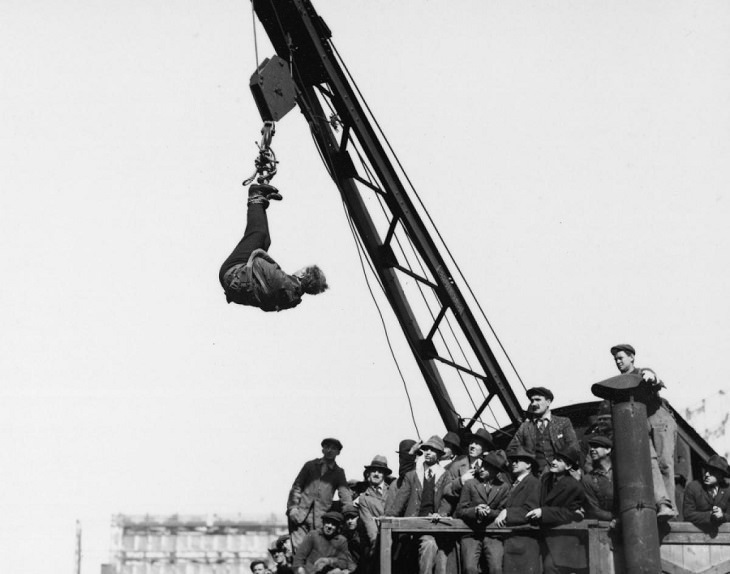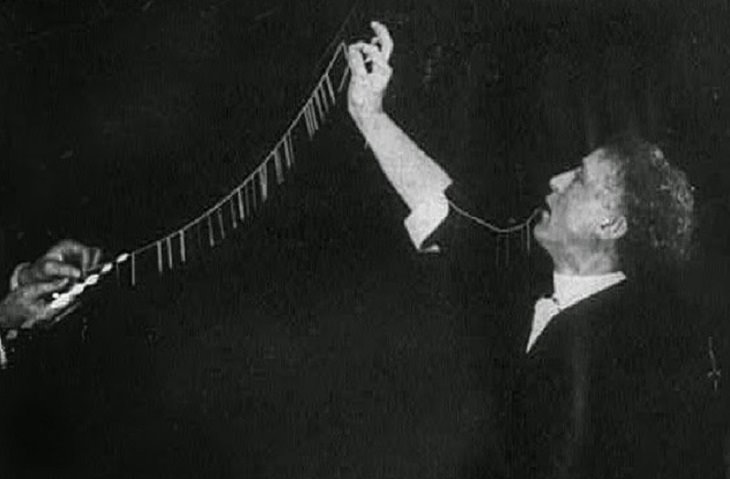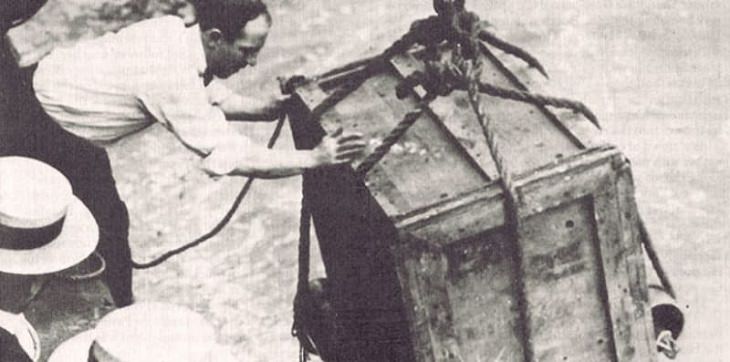
In the world of magic, there is an unwritten rule never to reveal how a trick is done. Therefore, when an exhibition in 2004 explained how Harry Houdini did his illusions, the world was apoplectic. David Copperfield declared it a breach of magical protocol and performers declared that they would boycott the exhibition – many claimed that they were still using Houdini’s tricks themselves.
However, Houdini had been dead nearly 90 years. Despite their claims, few illusionists today use his dated techniques. To add to this, the great magician’s secrets had been revealed decades earlier – he had been in his grave just three years when his team began spilling the beans.
Below we explain the secrets behind Houdini’s six greatest illusions.

Houdini created the “Radio of 1950” illusion for his evening shows from 1925 until his death the next year. The radio was a novelty at the time, and the act featured what Houdini said the radio would look like in 1950.
According to Dorothy Young, Houdini’s assistant, the magician would begin by introducing a large table with a tablecloth that fell halfway down the table’s legs. Houdini would walk around the table, lifting the cloth to show that there were no mirrors or anything else under the table.
Then his assistants would place a giant radio on the table. The front of the radio had huge dials and double doors. Houdini would open the doors to show that there was nothing inside except transformers, coils, and vacuum tubes. He would then close the doors.
Houdini would then adjust one of the dials until a radio station started playing. The radio announcer would say, “And now, Dorothy Young, doing the Charleston.” The top of the radio would fly off, and out would pop his young assistant, who would jump down and dance the Charleston.
The Secret
The key to this illusion was the table – known as a bellows table, it consisted of two table tops. The upper top had a trap door that opened upward while the lower top hung from the upper by springs that dropped under Ms. Young’s weight without going below the skirt of the tablecloth.
Young would be inside the radio when it was put on the table. She would then open the trap and slide into the bellowed area between the two table tops and wait there while Houdini showed his audience the empty interior. While the master magician was dialing the radio station, she simply climbed back into the radio.

Houdini performed the “Radio of 1950” illusion at the end of his career and life, but he performed the “Metamorphosis” illusion at the start, when he and his wife (Bessie) took their act on the road in 1894. Houdini didn’t invent this illusion, but earlier versions of the act had featured two men changing places. Houdini’s version became a sensation, catching the attention of the Welsh Brothers Circus, and they took the Houdinis on tour in 1895.
The illusion was pretty complicated. Houdini’s hands were tied behind him, and he was placed in a sack that was knotted closed. The sack was then placed inside a box, locked, and strapped closed. The box was then placed in a cabinet with a curtain.
Bessie would then step into the cabinet and draw the curtain closed. She would then clap three times and on the third clap, Houdini drew back the curtain, and Bessie was gone. She would then be found in the sack in the box, with all the locks and straps still in place and her hands bound behind her.
The Secret
The secret behind this illusion is pretty simple: practice. First, Houdini was an expert on knots and ropes, and his hands were tied by a knot that was easily slipped. By the time the sack was pulled over his head, his hands would have been free. The sack had eyelets around the top edge that allowed the rope to feed inside and outside the bag. Houdini simply pulled on the rope from the inside to loosen it.
After Houdini was placed in the box, he wiggled out of the sack while Bessie locked and strapped the box lid. Once Bessie had drawn the curtain closed, Houdini slipped out through a rear panel in the box. Contrary to the audience’s assumptions, Houdini clapped, not Bessie. He would clap once, then help Bessie into the box through the rare panel without disturbing the locks or straps.
On the third clap, Houdini would open the curtain. While he unlocked and unstrapped the box, Bessie would wiggle into the sack and slip the ropes round her wrists. They practiced so thoroughly that Houdini was out and Bessie was in his place in three seconds flat.

This act was born completely out of sibling rivalry. Houdini’s younger brother, Hardeen, had his own show, and both brothers were performing escapes from straitjackets behind screens. When one audience member demanded that Hardeen escape in front of them, he obliged and received a standing ovation. When he told his older brother what had happened, Houdini decided that he had to outdo his brother and so he developed the Hanging Straitjacket Escape. He would frequently perform this act a few hours before his evening shows to draw a bigger audience.
Houdini usually performed this act out on the street in front of a large crowd. He would be strapped into a straitjacket in front of the crowd, with his ankles bound. A crane then lifted him up so that the audience could see what he was doing, enforcing the impression that there was no trick to this feat.
The Secret
In his book “Handcuff Escapes,” Houdini revealed how he escaped from straitjackets. The key was acquiring slack inside the jacket as it was strapped on. Therefore, as the jacket was being slid on, Houdini would make sure that his arms were crossed across his chest, his stronger right arm on top. As the jacket was being brought around the back, Houdini would pinch and pull outward to loosen material around his chest. As the jacket was being cinched and tightened, Houdini held on to this slacked material. As the jacket was being buckled at the back, Houdini took a huge breath to expand his chest. This meant that when the jacket was in place, he had a fair amount of wiggle room in front.
Once in the air, upside down, Houdini would use his strong arm to violently force his weak left elbow to the left and away from his body. This forced the slack around the right shoulder, allowing Houdini to pull his right arm over his head.
Houdini wrote that, “Once having freed your arms to such an extent as to get them in front of your body, you can now undo the buckles and the straps of the cuffs with your teeth.” Once the cuffs were freed, Houdini would unbuckle the neck, top, and bottom buckles. Once they were undone, Houdini could slip his arms free and wiggle out of the jacket. Despite popular belief, dislocating his shoulder was not usually necessary, and Houdini only did it as a last resort.
Houdini became so adept at this trick that he managed to reduce the escape time from 30 minutes down to just three.

No one knows how old this illusion is, but it’s appropriately named. The oldest known magician to perform it was a Hindu of unknown nationality named Ramo Sami who toured America in 1820. It’s believed that Houdini, as early as 1899, rescued it from circus sideshows for his stage show. It went on to become a staple of his shows.
Houdini would have a spectator examine 50-100 needles and 18 meters of thread. The same spectator was then asked to examine Houdini’s mouth. The magician would then swallow the needles and thread all at once with a drink of water. Moments later, Houdini would regurgitate them, feeding out the thread, the needles dangling from it.
The Secret
Three years after Houdini died, the master’s prop engineer, R.D. Adams, revealed how this trick was done. Houdini would place a packet of thread with needles already attached to it between his cheek and teeth. The needles were threaded with a knot before and after it to keep them from coming loose in Houdini’s mouth. The knots were spaced to give the needles a natural play on the thread. This thread was then rolled into a flattened packet and inserted into the magician’s mouth like a tobacco plug.
When Houdini asked the spectator to inspect his mouth, he spread his upper and lower lips away from his gums and teeth with his fingers. Naturally, the fingers hooked around the lips into the cheek area, hiding the packet under his finger. If the spectator asked Houdini to move his fingers, he would mere slip the packet under his tongue.
Houdini would then place the loose needles and thread on his tongue and pretend to swallow them with a drink of water. However, in reality, Houdini spat the needles and thread into the water glass, leaving enough water in the glass so that the reflection obscured them. If the spectator remained close by, Houdini would slip the loose needles under his tongue and keep them there until the end of his trick. Once finished, he would take another drink of water, spit out the needles, and quickly hand the glass to his assistant. Finally, Houdini would spool out the pack of needles from his mouth.

Houdini began performing this trick in 1901. Due to his presentation, it became one of his most famous and captivating illusions. He went on to describe it as “the best escape that I have ever invented.”
Houdini would tell spectators to examine a milk can, allowing them to kick it to verify its sturdiness. The can was 1 meter tall, and the lid had six hasps that slipped over six eyelets attached to the can’s collar. Spectators would fill the can with water while Houdini changed into his bathing suit. When he returned, he would ask the audience how long they could hold their breath for. Few could exceed the minute mark.
Smiling, Houdini would climb into the milk can. When the lid was placed on top, Houdini was forced to submerge his head. The six hasps were secured, and locks were clasped on the eyelets. By this time, Houdini would have already been underwater for at least one minute. A screen was then erected around the can, and two more minutes later, Houdini would emerge, wet and out of breath. The locks on the milk can’s lid would still be in place.
The Secret
A couple of years after he died, a friend of Houdini revealed the secret. The collar was not really riveted to the can. The simple construction of the can made it appear secure, but the collar rivets were fake. Since the collar was tapered and greased, anyone who examined the milk can could not pull the collar off or even budge it, but anyone inside could easily push the collar up and climb out without disturbing the lock.

Houdini’s career was a steady progression of increasingly great escapes. When escaping from handcuffs grew stale, he moved onto jail escapes. In 1907, he jumped from bridges, handcuffed. In 1908, it was the Milk Can Escape. Finally, in 1912, it was the Underwater Box escape.
His very first Underwater Box Escape was made off the side of a barge into New York’s East River. Houdini was handcuffed and then climbed into the crate. The crate was then nailed shut, trussed, and chained shut. It was then hoisted into the river, where it sank, and 150 seconds later, he appeared on the surface a short distance away.
The Secret
The secret, of course, lay in the crate’s design. First, the crate had small holes in it allowing Houdini to breathe while he waited for the box to be nailed, trussed, and chained. They also allowed the crate to sink. Second, the crate was square, with four boards on each side. On one of these sides, the bottom two boards were not nailed to the crate. They only sported nail heads. Instead, the boards were a hinged trap, the opening secured by a latch. According to Adams, Houdini would remove his handcuffs while the crate was being nailed shut. He would then wait until the crate was in the water, open the trap, then swim to the surface.
During one escape, Houdini waited until the crate hit the river bed before opening the trap. However, the crate landed with the trap at the bottom, and the muddy bed kept the hinge door from opening. Houdini managed to escape by desperately flailing against the side of the crate so that it overturned. Ever afterward, Houdini made sure that the trap was open well before he reached the bottom.
Source: gizmodo